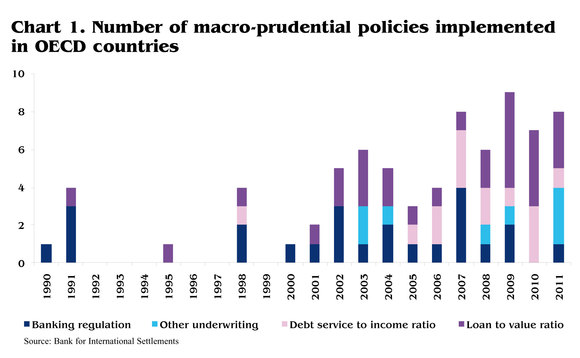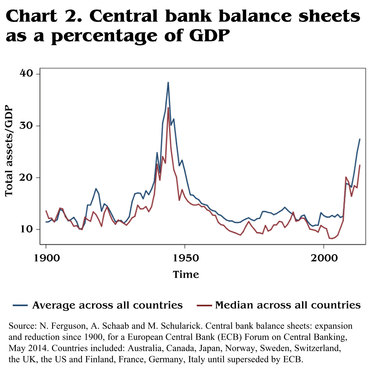
The reorientation of central bank policy objectives

Twenty-five years seems like a lifetime in central banking. Re-reading some of Alan Greenspan’s speeches and testimonies from 1988–1989, we suspect that today’s central bankers would gladly exchange the challenges of 2014 for those of 1989. The preoccupations of the US Federal Reserve at that time were the aftermath of the October 1987 stock market crash, the demise of Soviet communism and its hoped-for replacement by the market economy, and the uncomfortably high level of US price inflation. The financial stability issues thrown up by the 1987 crash pale into insignificance in comparison with those exposed by market dislocations in 2007–2008. How the class of 2014 would love to have the job of controlling high inflation; instead, many of its members remain preoccupied and perplexed by the threat of outright deflation.
The global financial crisis has prompted a fundamental reassessment of policy priorities, with radical implications for the role of central banks. In this essay, we focus on three aspects of the intensification of the challenges facing the major central banks today. First, the renewed emphasis on global financial stability and the ascendancy of macro-prudential policy; second, the reappearance and restatement of the threat of fiscal dominance; and third, the operational challenge to policy tightening posed by the huge expansion of bank reserves, itself a legacy of post-crisis policy responses.

Peter Warburton (right), and Joanna Davies, Economic Perspectives.
The renewed emphasis on global financial stability
In the wake of the global financial crisis, central banks have been criticised for focusing too narrowly on their price stability mandates. It is argued that excessive monetary policy accommodation – principally, the maintenance of low nominal interest rates – was responsible for the extension and exaggeration of the private sector credit boom. However, the punishment for this crime is not to have central banks’ powers reduced but, rather, enhanced. Finding no other body of comparable technical expertise in the official sector, governments have charged central banks with additional responsibilities for macro-financial stability and the oversight of financial institutions deemed to be systemically important. While monetary and financial stability objectives may appear symmetrical, the former is defined typically in terms of a specified range or central tendency for inflation, and the latter is defined in terms of the absence of instability or crisis. It is much harder to design, or to evaluate, policies that seek to avoid negative outcomes.
Central banks have taken diverse approaches in accommodating this expanded role. The US, UK, Canada and Switzerland, for example, have deployed a separate toolkit, known as macro-prudential policy, to address financial stability concerns. In contrast, Norway and Sweden’s monetary policy decisions have been explicitly influenced by financial stability concerns. The Riksbank raised its repo rate from 0.25% to 2% in 2010–2011 in an attempt to ward off financial instability. Similarly, Norway’s policy-makers raised interest rates in 2010 when inflation was below target and output subdued as a means of “guarding against the risk of future imbalances.” More recently, Sweden’s central bank has abandoned efforts to counter high levels of household debt with monetary policy, cutting the policy rate by an unexpectedly large 50 basis points to 0.25% as it refocuses on averting deflation.
Both approaches to the accommodation of a wider policy brief have their drawbacks. The use of monetary policy to target two, sometimes conflicting, objectives runs the risk of inconsistency. Quantitative easing, for example, enacted by monetary policy committees to strengthen bank balance sheets and encourage lending, is believed to have contributed to the build-up of new asset bubbles. Similarly, the application of macro-prudential restrictions in a bid to build resilience and safeguard against future financial crises, is criticised for slowing the pace of economic recovery. Macro-prudential policy is still at the experimental stage. As highlighted by Janet Yellen in a speech on July 2, 2014, “its effects on financial vulnerabilities, such as excessive leverage and maturity transformation, are not well understood and are less direct than a regulatory or supervisory approach.”1
Despite the difficulties in combining macroeconomic and financial stability objectives, central banks have forged ahead, spurred on by academics and government officials, eager to gain greater traction for policy. The most prominent campaign has been for monetary policy-makers to allow inflation under- or overshoots “in order to reduce the likelihood of something nastier down the road”. In the view of Charlie Bean, in a speech delivered at the London School of Economics in May 2014, policy-makers should be prepared to lean against financial instability, even if it means deliberately neglecting their inflation objectives.2
Notably, near-zero interest rates, which were expected to prevail for only a brief period in the context of the global credit emergency, have remained in place for more than five years. Fearful of triggering another bout of corporate defaults, banking write downs and government bailouts, the policy bias has been towards macro-prudential policy tightening rather than interest rate tightening. The appeal of such policies, for example loan to income caps, over traditional monetary policy tightening is clear; while the former can be targeted at specific segments of the economy, interest rates are considered a blunt tool. The danger, on the other hand, is that the introduction of non-binding macro-prudential regulation serves as a substitute for a timely increase in interest rates.
Moreover, macro-prudential policy is vulnerable to arbitrage. The proliferation of the shadow banking sector (so named because the activity takes place outside regulatory parameters) is evidence in itself. There is concern that macro-prudential policy tightening may lack the desired element of surprise. If used as a substitute for monetary policy, as chart 1 alludes, then policy may remain unintentionally looser for longer. 
The reappearance of fiscal dominance
Since the global financial crisis, fiscal dominance – the extent to which fiscal deficits condition the growth of the money supply – has reappeared as a threat to central bank independence. As long as the growth of bank lending to the private sector remains weak, or even negative, in most Organisation for Economic Co-operation and Development (OECD) countries, the public sector contribution to broad money supply growth is viewed in a positive light. However, the persistence of large structural budget deficits carries sinister connotations when weighed on the scales of history. While central banks have always characterised their large-scale asset purchases (of mainly government debt) as temporary and reversible actions, there is a growing risk that budgetary disciplines are weakened as a result and that politicians become complacent regarding the role of central banks in financing fiscal deficits.
In 1989, Alan Greenspan warned against reduced central bank independence; noting that “attempts to hold interest rates at unsustainably low levels have been shown to result in accelerating inflation. Even gradual increases in nominal interest rates may not be sufficient to contain an accelerating inflation once it begins.”3 Despite his forewarning, in the context of burgeoning public sector debts, unconventional monetary policy and its dampening effects on bond yields have become the favoured approach of politicians and policy-makers.
Lest we forget, the rediscovery of fiscal discipline in the 1980s played a central role in the deceleration of broad money supply growth and set the scene for the disinflation of the 1990s. Structural budget deficits of 5% or 6% of GDP, let alone 8% or 9% of GDP, are incompatible with long-run monetary stability and the inflation objectives of independent central banks. John H. Cochrane, writing in National Affairs in 2011, summarises the fiscal dominance threat thus: “If people become convinced that our [US] government will end up printing money to cover intractable deficits, they will see inflation in the future and so will try to get rid of dollars today – driving up the prices of goods, services and eventually wages across the entire economy.” He identifies the rolling of substantial short-term public debt as a key context of vulnerability as inflation expectations become unanchored.4
The threat of fiscal policy dominating monetary policy to the detriment of policy independence is closer at hand than it has been for many years. As a consequence, monetary policy normalisation must now also consider the stability of public sector finances. While advanced economy governments produce routine projections of the public finances for five to eight years ahead that purport to assure investors that budgetary balance is an attainable target, so often these exercises make unjustifiably optimistic assumptions about productivity growth and cost control. In reality, global economic growth has failed to recover as promptly or as powerfully as forecast. With governments reluctant to enact fiscal restraint, fiscal deficits are wider and public debt ratios larger than originally foreseen. The temptation is for policy-makers to repress interest rates along the government yield curve and to condone an inflationary episode as a means of eroding the real value of government debt. While there has been little discussion of fiscal dominance thus far, the threat is obvious.
Central banks have accumulated vast amounts of domestic government bonds, unparalleled in peacetime (chart 2). Central bank balance sheets in both the US and Japan are still expanding. Having become such a prominent feature of post-crisis policy, the merest hint of even a modest policy shift has the power to trigger a sharp reversal in global bond, equity and gold prices as demonstrated by the US ‘taper tantrum’ in May last year. Much more so, the impact of an interest rate increase.
Operational difficulties of central bank tightening
Twenty-five years ago, when a central bank policy committee decided to tighten, it would announce a new short-term interest rate and would validate it immediately in the money markets using open market operations. After five years of unconventional monetary policy and near-zero interest rates, life has become far more complicated, particularly for the US Fed. The sizeable expansion of central bank balance sheets, financed by banks’ excess reserves, poses an operational dilemma for policy-makers. The scale of the phenomenon has been seen only once before, during the Second World War. Ordinarily, excess reserves would be drained from the money markets as a prelude to raising interest rates. However, such is the scale of these bank reserves that this option is impractical. Ferguson, et al. concluded a recent study as follows: “A key finding is that only a few of the large balance sheet contractions in our sample were achieved by a nominal contraction in total assets. Instead, central banks generally normalised their balance sheet size over time as GDP grew, simply by holding total assets stable for a while.”5 The exceptions to this overarching pattern are the reductions during the Nordic crisis, the Bank of Japan’s unwinding of its asset purchase programme and after recent lender of last resort measures.
The impracticality of a large-scale disposal of the US Fed’s balance sheet assets – particularly as its longer duration purchases are trading well beneath their respective purchase prices – will require the Federal Open Market Committee to raise the interest rate on excess reserves (IOER) alongside the federal funds rate. However, the existence of a large shadow-banking sector threatens to undermine the role of the funds rate in setting a floor for money market rates. The complexity of the situation arises from the fact that non-banks, flush with liquidity and which do not qualify for the IOER, would undercut the Fed funds rate and frustrate its intention to tighten.
In order to regain better control over the interest rate structure, the Fed could make overnight reverse repurchase facilities available to an expanded list of counterparties (including the government-sponsored enterprises and the money funds). While the US Fed has not yet signalled it is ready to begin the tightening cycle, there is growing nervousness that it may not be able to enforce a higher level of interest rates in the market in the presence of widespread risk aversion and liquidity preference.
Summary
While central bankers may long for the simplicity of the monetary policy challenges of 25 years ago, there is no likelihood of a return. The policy landscape for central banks has been transformed by the reorientation of the global financial system, the proliferation of credit instruments and the growth of shadow banking. A corresponding increase in the size and complexity of the policy toolkit demands greater awareness of the potential for unintended consequences.
Peter Warburton is director of Economic Perspectives, an international economics consultancy that offers independent thinking and perspectives on global macro-economic and financial issues.
Joanna Davies is a senior economist at Economic Perspectives.
Notes
1. Yellen, Janet L. (July 2, 2014), Monetary Policy and Financial Stability, speech given at the 2014 Michel Camdessus Central Banking Lecture International Monetary Fund. http://www.federalreserve.gov/newsevents/speech/yellen20140702a.pdf
2. Bean, Charlie (May 20, 2014), The Future of Monetary Policy, speech given at the London School of Economics. http://www.bankofengland.co.uk/publications/Documents/speeches/2014/speech729.pdf#
3. Greenspan, Alan (October 10, 1989), Commercial Banks and the Central Bank in a Market Economy, speech given at Spaso House, Moscow. https://www.kansascityfed.org/publicat/econrev/EconRevArchive/1989/4q89gree.pdf
4. Cochrane, John H. (2011), Inflation and debt, National Affairs, 9, Fall 2011. http://www.nationalaffairs.com/publications/detail/inflation-and-debt
5. Ferguson, Niall, Andreas Schaab and Moritz Schularick (May 2014), Central Bank Balance Sheets: Expansion and Reduction since 1900, ECB forum on Central Banking. https://www.ecbforum.eu/up/artigos-bin_paper_pdf_0551614001400679837-360.pdf
Download a complimentary edition of Economic Perspectives’ latest Global Inflation Perspective
Download/read the article in PDF format
Sponsored content
Copyright Infopro Digital Limited. All rights reserved.
You may share this content using our article tools. Printing this content is for the sole use of the Authorised User (named subscriber), as outlined in our terms and conditions - https://www.infopro-insight.com/terms-conditions/insight-subscriptions/
If you would like to purchase additional rights please email info@centralbanking.com
Copyright Infopro Digital Limited. All rights reserved.
You may share this content using our article tools. Copying this content is for the sole use of the Authorised User (named subscriber), as outlined in our terms and conditions - https://www.infopro-insight.com/terms-conditions/insight-subscriptions/
If you would like to purchase additional rights please email info@centralbanking.com